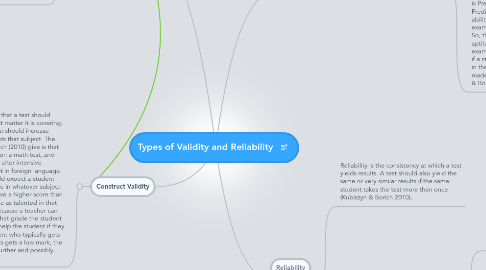Types of Validity and Reliability
by Ramah Myers


1. Construct Validity
1.1. Construct validity means that a test should correspond to the subject matter it is covering, and the scores on the test should increase after teaching the students that subject. The example Kubiszyn & Borich (2010) give is that a student would do well on a math test, and the score would increase after intensive coaching in math, but not in foreign language. However, a teacher should expect a student who has a higher aptitude in whatever subject is being covered to receive a higher score than a student who may not be as talented in that area. This is important because a teacher can be better prepared for what grade the student might get, and possibly help the student if they start to slip. So, if a student who typically gets a high mark on math tests gets a low mark, the teacher can investigate further and possibly help the student.
2. Criterion-Related Validity Evidence
2.1. The first type of criterion-related validity evidence is Concurrent-Related validity evidence. This measures the similarity between a possible new test that might be given and a well established test. If a new test is a possible choice for test-makers, the test will be given with a well established test and the scores will be compared. If the scores are similar for the respondents. then the tests are similar enough to be given as equals. This is important because this gives educators and test distributors options, instead of just one test. (Kubiszyn & Borich 2010)
2.2. The second type of criterion-related validity evidence is Predictive validity evidence. Predictive validity evidence is the ability of the test to predict how the examinee will behave in the future. So, this could be applicable on aptitude tests or psychological exams. This is important because if a student is predicted to do well in the future, changes can be made to their curriculum (Kubiszyn & Borich 2010).
3. Reliability
3.1. Reliability is the consistency at which a test yields results. A test should also yield the same or very similar results if the same student takes the test more than once (Kubiszyn & Borich 2010).
3.2. There are three major types of reliability.
3.2.1. Test-Retest or Stability: What this means is that the test must be able to have similar scores if the test is taken twice. This shows that the scores correlate.
3.2.2. Alternate forms or equivalence: Basically what this means is that if there are two or more types of a test that are similar, the different types will be given and then the scores from the two tests are compared. If the scores correlate, it shows that the tests are both relabile enough to use interchangably.
3.2.3. The third type is Internal consistency. With this, the examinee is expected to answer quesetions consistently. If a person is answering questions, they should be answering similar questions consistently within a test. This shows they are reliable.
